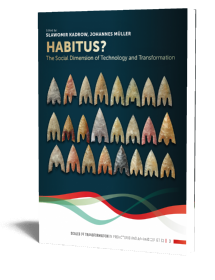Abstract:
This book examines the mutual influence of architecture and human action during a key period of history: the Hellenistic age. During this era, the profound transformations in the Mediterranean’s archaeological and historical record are detectable, pointing to a conscious intertwining of the physical (landscape, architecture, bodies) and social (practice) components of built space.
Compiling the outcomes of a conference held in Kiel in 2018, the volume assembles contributions focusing on Hellenistic architecture as an action context, perceived in movement through built space. Sanctuaries, as a particularly coherent kind of built space featuring well-defined sets of architecture combined with ritual action, were chosen as the general frame for the analyses. The reciprocity between this sacred architecture and (religious) human action is traced through several layers starting from three specific case studies (Messene, Samothrace, Pella), extending to architectural modules, and finally encompassing overarching principles of design and use. As two additional case studies on caves and agorai show, the far-reaching entanglement of architecture and human action was neither restricted to highly architecturalised nor sacred spaces, but is characteristic of Hellenistic built space in general.
Contents
Acknowledgements
Introduction: Hellenistic Architecture, Landscape, and Human Action
Annette Haug – Asja Müller
Three sanctuaries as case studies
The Sanctuary of Artemis Limnatis in Messene: Natural Setting and Human Action
Stefan Feuser – Maria Spathi
Interstitial Space in the Sanctuary of the Great Gods on Samothrace
Bonna D. Wescoat – Susan Ludi Blevins – Maggie L. Popkin – Jessica Paga – Andrew Farinholt Ward – Michael C. Page – William Size
Sanctuary Disposition and Cult Practice: The Thesmophorion in Pella
Soi Agelidis
Principles of design: Hellenistic sanctuaries between agency and perception
The Usage of the Pronaos of Hellenistic Temples
Philipp Kobusch
Constructing the Sublime: Landscape, Architecture and Human Encounter in Hellenistic Sanctuaries
Christina G. Williamson
Secluded or Entangled: Two Modes of Architecture-Landscape Design in Hellenistic Sanctuaries
Asja Müller
Roman Awe for Greek Sanctuaries: Polybius and Livy Illustrate Roman Encounters with Greek Patrimony
Jessica van ‘t Westeinde
Man-Made Space versus Natural Space in Greek Sacred Caves
Katja Sporn
Beyond sanctuaries: the agora
The Upper Agora at Ephesos in Hellenistic Times: in Search of the ‘State Market’ (in honour of Wilhelm Alzinger, 1918-1998, on his centenary)
Dirk Steuernagel


Prof. dr.
Annette Haug
Institute of Classical Studies / Classical Archaeology, CAU Kiel (present). Studies of Classical Archaeology, Art History and Prehistory in Heidelberg and Paris, binational PhD 2003, Habilitation Leipzig 2009, LMU München Heisenberg Fellow. Since 2012, Professor of Classical Archaeology at the Christian-Albrechts-Universität zu Kiel. PI of the ERC Consolidator Grant “Decorative Principles in Late Republican and Early Imperial Italy” 2016-2022. Former co-speaker and actual PI of the Cluster of Excellence ROOTS.
read more

Asja Müller
M.A.
Institute of Classical Archaeology, Freie Universität Berlin (present). Studies of Classical Archaeology, Prehistoric Archaeology, Experimental Archaeology and Egyptology at Leipzig and Exeter (UK); PhD Kiel 2017; Postdoc Research Fellow CRC 1266, project E3 at the Institute of Classical Studies / Classical Archaeology, CAU Kiel, 2016-2017; Travel Scholarship of the German Archaeological Institute 2017-2018; Assistant Professor at the Institute of Classical Archaeology, Freie Universität Berlin 2018-.
read more












